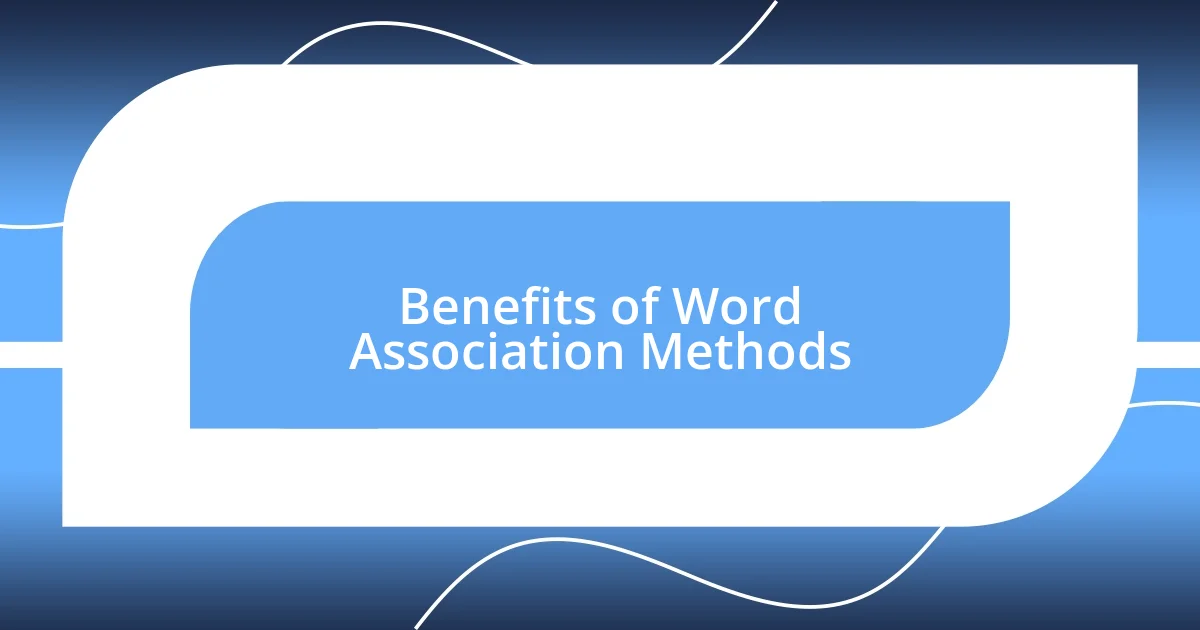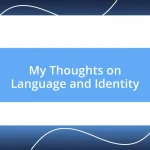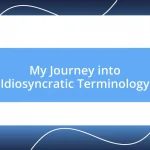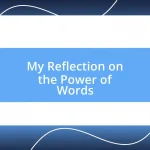Key takeaways:
- Word association techniques enhance memory retention and creativity by linking new information with personal experiences and emotions.
- Effective word linking can be achieved through storytelling, sensory details, and visual aids like color coding.
- Practical exercises, such as word maps and emotional pairings, help reinforce associations and foster creative thinking.

Understanding Word Association Techniques
Word association techniques are fascinating tools that allow us to tap into our subconscious. For instance, when I think of the word “beach,” countless images flood my mind—sand, waves, and laughter. It’s intriguing how our minds instantly create connections, often based on emotions or personal experiences, isn’t it?
I remember a time when I was preparing for an exam, and I used word associations to memorize complex terms. Linking “photosynthesis” to “sunshine” not only made the concept more vivid in my mind but also brought back memories of sunny days in the garden. This method transformed dry facts into a story that resonated with me.
Have you ever tried to recall a list of names or items? Using word associations can make a seemingly overwhelming task feel more manageable and even enjoyable. It’s like creating a mental map where each word leads you to another, making the whole experience immersive and less daunting.

Benefits of Word Association Methods
Word association methods offer an array of benefits that can significantly enhance memory retention and creativity. Personally, I’ve found that these techniques allow me to explore different angles of a topic and spark innovative ideas. For example, when brainstorming for a project, associating “winter” with “cozy” led me to consider themes of warmth and comfort, which completely transformed my approach.
Here are some key benefits I’ve observed:
– Improved Memory Recall: By forming strong associations, I can retrieve information quickly and effortlessly.
– Enhanced Creativity: Associating seemingly unrelated words helps me see concepts from fresh perspectives.
– Reduced Anxiety: Tasks feel less intimidating when I connect words to personal experiences or familiar scenarios.
– Stronger Learning Connections: Integrating emotions with new vocabulary makes the material emotionally resonant.
– Engagement: The playful nature of word association makes learning feel more like a game than a chore.
By using associations, I’ve cultivated a more dynamic learning and creative process that truly reflects the interconnectedness of thoughts and ideas.

How to Create Word Associations
Creating word associations starts with tapping into your personal experiences. When I want to remember a specific word, I often think about the people or places that relate to it. For example, if I’m trying to recall the word “journey,” I might envision the road trip I took last summer. Associating that word with vivid memories helps cement it in my mind, making recall much easier.
To establish effective word associations, I find it beneficial to visualize and even draw connections between words. Let’s say I’m studying science terms; associating “atom” with “building blocks” creates a clear mental image. I also recommend using a journal to jot down words and their associations. This not only solidifies your understanding but also serves as a handy reference when you need it later.
Another technique involves using synonyms or antonyms to expand associations. When I think of “happy,” I might connect it to “joyful,” “content,” or even “elated,” which enhances my vocabulary and deepens my understanding of each word. The more connections you create, the richer your word associations become, leading to a more vibrant mental landscape.
| Technique | Description |
|---|---|
| Personal Experience | Link a word to a personal memory for better recall. |
| Visualization | Use mental images or drawings to create strong associations. |
| Synonyms/Antonyms | Expand your vocabulary by connecting words with similar or opposite meanings. |

Techniques for Effective Word Linking
Effective word linking requires a blend of techniques that resonate personally. One method I often utilize is linking words through stories. When I’m trying to remember a complex term, I craft a tiny narrative around it. For instance, associating the word “exploration” with an unforgettable hike I took makes the term come alive in my mind. Have you ever found that evoking a story enhances your memory? It truly works wonders for me.
Another powerful technique is employing sensory details in your associations. When I think of the word “summer,” I immediately picture the smell of sunscreen and hear laughter from the beach. By anchoring words to sensory experiences, they become more vivid and memorable. I often ask myself, what colors, sounds, or textures come to mind when I consider a particular word? I find this approach transforms abstract ideas into tangible experiences.
Lastly, using color coding can add an extra layer of meaning to your word associations. I have a colored system in my notes where each category gets its hue. So, words related to creativity might be in bright orange, while terms linked to emotion are in calming blue. This visual aspect helps me make connections that I might overlook otherwise. Have you tried something similar? I believe that incorporating color not only makes learning more enjoyable but also helps deepen the connections between words in a more memorable way.

Practical Exercises for Word Association
When it comes to practical exercises for word association, I love the idea of a word map. I often start with a central word that intrigues me and branch out with related terms, thoughts, or images. This visual representation not only helps me see connections but also inspires creative thinking. Have you ever tried this technique? It feels like watching your ideas blossom on paper.
Another exercise that really resonates with me is pairing words with emotions. For instance, when I think of “freedom,” I might connect it with feelings of joy or exhilaration, perhaps recalling a moment when I felt completely unconfined. This not only solidifies the word in my mind but also enriches my emotional vocabulary. It’s fascinating how tapping into feelings can deepen our understanding of language, isn’t it?
A fun and effective exercise I like is the “word relay.” I take a random word, say “ocean,” and then write down the first word that comes to mind, like “waves.” From “waves,” I might jump to “surfing,” and then to “adventure.” Each link builds on the last, giving me a chain of associations that intertwine concepts in surprising ways. Have you experienced that spark of creativity when words flow freely? It’s amazing how this technique can unveil connections I might not have otherwise considered.












